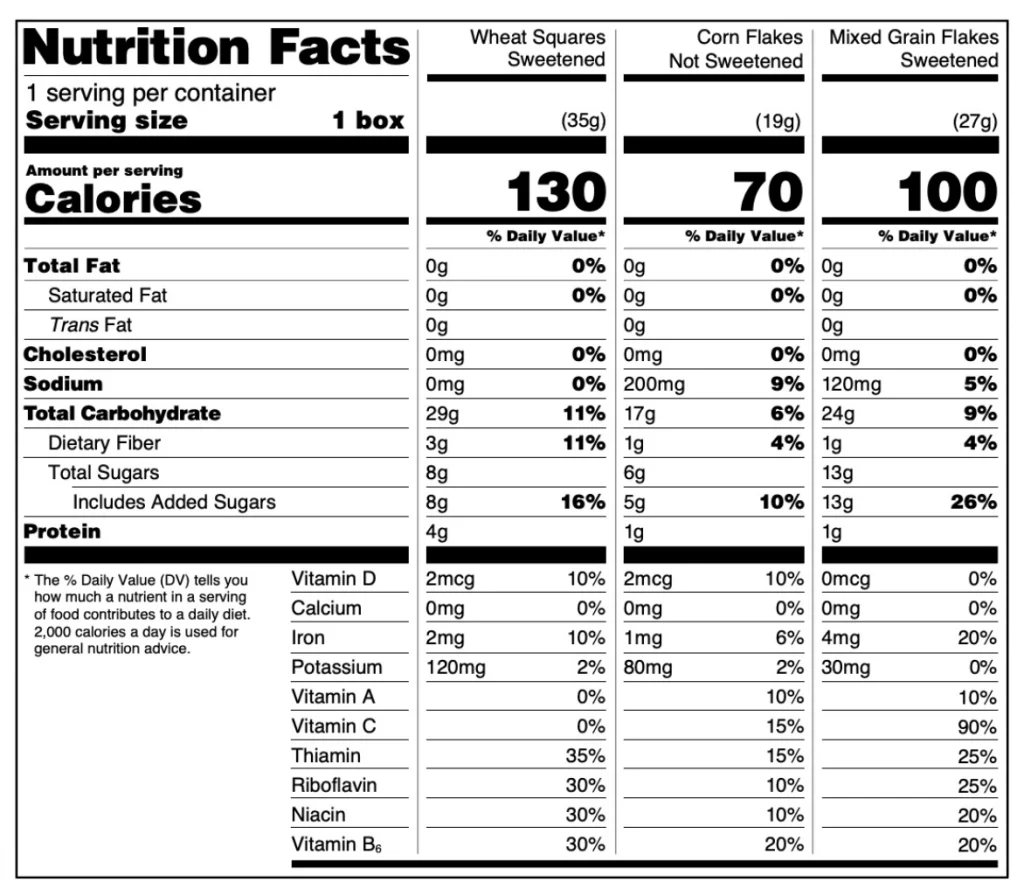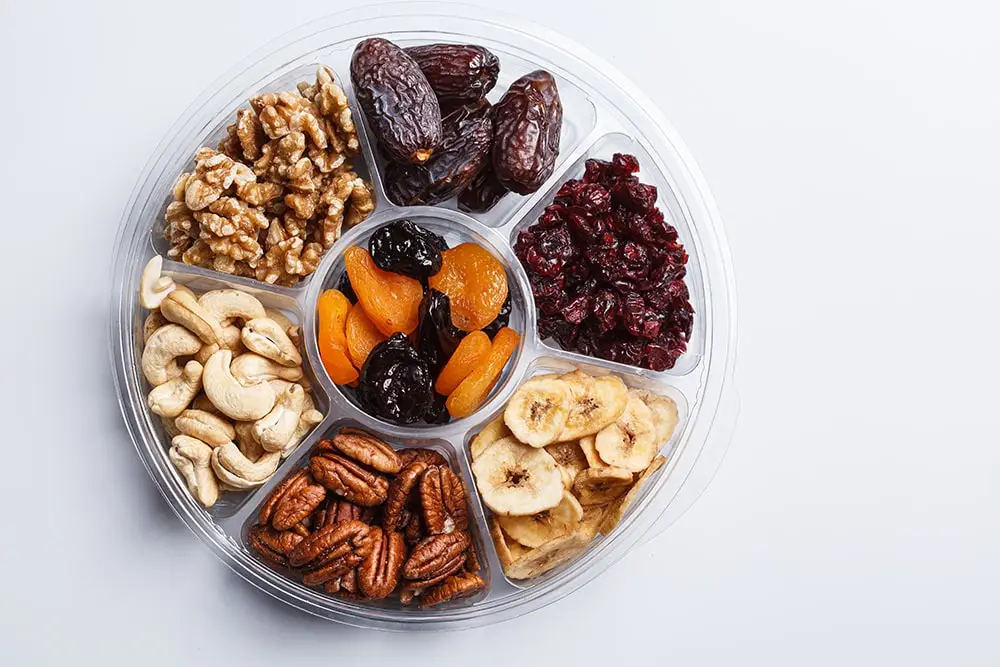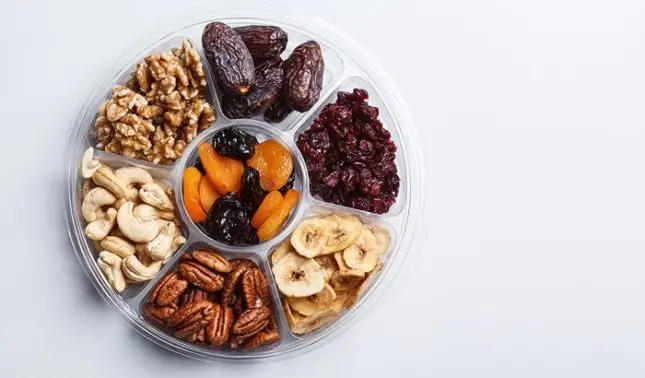Creating compliant nutrition labels for multi-pack products presents unique challenges for food manufacturers. An aggregate nutrition facts label provides detailed nutritional information for multiple food items that are packaged together, such as fruit and nut mixes or assorted cereal boxes. While the FDA and other regulatory bodies like CFIA don’t mandate aggregate labels, this format offers an efficient way to display comprehensive nutritional data when space is limited.
For food manufacturers navigating these requirements, Food Label Maker’s label creation tool streamlines the process of creating compliant aggregate labels. Our software ensures accurate nutrient calculations, proper formatting, and alignment with current FDA guidelines, helping you maintain compliance while optimizing valuable packaging space.
Key Components of an Aggregate Nutrition Label
An aggregate nutrition facts label is a comprehensive solution for products containing multiple items with distinct nutritional profiles. Unlike standard nutrition labels, this specialized format presents detailed information for each product in a clear, organized manner. Understanding the mandatory components of this label ensures that FDA requirements are met while effectively communicating nutritional information to consumers.

Column organization
The foundation of an aggregate nutrition facts label lies in its multi-column structure. Each product variety receives its own column, creating a side-by-side comparison that allows consumers to reference nutrition information easily. The FDA guidelines specify precise requirements for column layout, such as:
- Headers clearly identify each product variety
- Nutrient values aligning consistently across all columns
- Column widths are equal to ensure readability
- Spacing between columns must meet minimum requirements for visual clarity
Serving size declarations
Accurate serving size information is vital on any nutrition facts label, particularly in aggregate formats. Each column must display:
- Clear, standardized serving sizes specific to each product variety
- Both household and metric measurements (for example, 1 box (35g)(19g)(27g))
- Total package contents for each variety
- Number of servings per container
Serving sizes and dual measurement systems ensure consumers can easily understand and compare portion sizes across different product varieties.
Nutrient information presentation
The presentation of nutrient information follows strict FDA guidelines while maintaining clarity across multiple columns:
- Mandatory nutrients appear in the FDA’s prescribed order, starting with calories
- Calorie content receives prominent placement and bold formatting
- Percent Daily Values (% DV) align precisely across all columns for easy comparison
- Decimal points and percentages align consistently within each column
- Visual separation between different nutrient categories
Required formatting elements
To ensure compliance and readability, an aggregate nutrition facts label must adhere to specific formatting requirements:
- Key elements like calories and serving size appear in bold typeface
- Font sizes meet minimum requirements (6-point generally, 8-point for crucial information)
- Border specifications to maintain a consistent visual presentation
- Footnote placement has to follow FDA guidelines for placement and content
Why Is an Aggregate Label Important?
While aggregate nutrition facts labels aren’t mandatory for all multi-pack products, they play a crucial role in regulatory compliance and consumer communication. For products with limited packaging space, this format is an efficient solution to display comprehensive nutrition information for multiple items. It also allows consumers to still make educated and informed food choices.
Regulatory Compliance and Risk Mitigation
Implementing proper aggregate nutrition facts labels helps manufacturers maintain compliance with FDA regulations while protecting their business interests:
- The format satisfies FDA requirements for displaying nutrition information on multi-product packages, ensuring your products meet current labeling standards
- Proper implementation significantly reduces the risk of costly recalls or regulatory actions that could result from incorrect or unclear nutrition labeling
- The standardized format ensures consistency across all product varieties, helping maintain compliance across your product line and simplifying quality control processes
Consumer Information and Safety
Beyond regulatory requirements, aggregate labels serve a vital role in consumer education and safety:
- Shoppers can make informed purchasing decisions by easily comparing nutrition information across different varieties within the same package
- People with dietary restrictions or allergies can quickly identify whether a variety pack contains harmful allergens and see all nutrition information presented in a unified tabular format
- The clear presentation of serving sizes and portion information helps consumers maintain accurate portion control
- Side-by-side comparison of different varieties enables consumers to easily evaluate and compare nutritional content, supporting informed dietary choices
See How FoodLabelMaker Can Help You
What Packaging Labels Require Aggregate Labels?

Aggregate labels offer a strategic solution for products that combine multiple food items in a single package. While the FDA provides flexibility in how manufacturers display nutrition information for multi-product packages, understanding when to use aggregate labels helps optimize compliance and packaging efficiency.
Common Multi-Pack Products
The most commonly used examples of products requiring an aggregate nutrition facts label are:
Variety Snack Packs
Products with significantly different nutritional profiles require a clear and compliant aggregate nutrition facts label. These products include:
- Mixed chip flavors like Frito-Lay variety packs, where each bag contains different flavors of chips with distinct nutritional profiles
- Assorted granola bars such as Nature Valley variety boxes, offering different flavor combinations
- Mixed nuts packages that combine different nut varieties and dried fruits, and where fat content varies substantially between varieties
Cereal Variety Boxes
- Kellogg’s Fun Pak mini boxes offer multiple cereal types in single-serving portions
- Store-brand variety packs that combine different cereal flavors or types in individual portions
Assorted Chocolate Boxes
- Lindt truffle collections featuring different chocolate varieties and fillings
- Ferrero Rocher assortments combining multiple chocolate-covered confections
Note that assorted chocolate boxes with varying piece sizes or beverage multi-packs with different serving volumes need careful consideration in how serving sizes are presented.
Mixed-Flavor Beverage Packages
- LaCroix sparkling water variety packs with different flavors
- Capri Sun mixed juice box selections
- Gatorade or Powerade multi-flavor sports drink packages
Single-serving vs Multi-serving Packages
Single-serving and multi-serving packages often have different labeling requirements. For example, yogurt multi-packs with individual cups require aggregate labeling when each cup has a different nutritional profile (like mixed fruit flavors vs. plain).
However, multi-flavor ice cream containers might use either standard or aggregate formats, depending on how the product is typically consumed.
Common Aggregate Nutrition Facts Compliance Challenges

Creating compliant aggregate nutrition facts labels presents several key challenges that manufacturers must navigate. Space constraints pose a major hurdle, as manufacturers must ensure that nutrition information is still presented thoroughly on a limited packaging surface area. It must also maintain minimum font size requirements and accommodate design elements that allow a consumer to see and understand what they are reading.
Multiple serving sizes add another layer of complexity as manufacturers need to standardize serving size declarations across different product types while ensuring accurate representation of varying portion sizes. This includes maintaining consistency in measurement units and clearly communicating serving equivalencies to consumers.
Varying package counts require careful attention to detail. Manufacturers must accurately represent different quantities of each variety while calculating and displaying total package contents. This involves managing serving calculations for uneven distributions and coordinating package counts with serving size information to maintain clarity and compliance.
Facility allergen declarations present unique challenges, particularly when products come from multiple production facilities. Manufacturers must combine allergen information comprehensively while ensuring consistent warnings across all varieties. This includes managing cross-contamination declarations and maintaining uniform allergen statements that cover all potential risks.
Using Food Label Maker for Aggregate Labels
Creating compliant aggregate nutrition facts labels is a straightforward process with Food Label Maker’s intuitive software. Our specialized software guides you through each stage of your label creation, ensuring accuracy and compliance while saving valuable time and resources.
The process begins with setting up individual recipes in the system, where you’ll input specific ingredients from our extensive database, serving sizes, and other relevant information for your product. Once your recipe is established, it automatically calculates nutrition information and presents it succinctly on your food label, automatically applying FDA-compliant formatting and spacing.
We offer multiple label formats and styles, including the FDA aggregate label format. Once you’ve completed the nutrition analysis for your individual recipes in the tool, you can select and combine them to create an aggregate label.
Our software’s built-in compliance engine continuously validates your label’s formatting as you create it, checking elements like font sizes, spacing requirements, and mandatory nutrient declarations. This real-time verification helps catch potential issues before they become costly compliance problems for your brand.
Automated compliance checking and consistent updates act as a quality control measure, while allergen declarations are clearly stated across multiple products to ensure vulnerable consumers are accounted for.
Our customizable features allow you to edit nutritional information, change your label’s language, or even edit your label style for varying package sizes or countries in which you might sell your product. These tools work together to ensure your aggregate labels meet all regulatory requirements while maintaining clarity and readability.
Conclusion
As the food industry continues to innovate with multi-product packaging, the importance of accurate aggregate nutrition facts labels grows. These labels serve as crucial tools for both regulatory compliance and consumer information, making the choice of labeling solution increasingly important.
Food Label Maker provides the expertise and tools needed to navigate the complexities of aggregate labeling while staying ahead of evolving regulations. Our platform not only ensures compliance but also streamlines the entire label creation process, saving valuable time and resources.
It also offers expert nutrition label verification services, where certified nutrition professionals can review your recipes and labels to ensure complete compliance before you go to print.
Looking ahead, nutrition labeling requirements will likely become more complex, particularly for multi-product packages. Having a reliable, adaptable labeling solution helps future-proof your products for compliance and consumer transparency.



